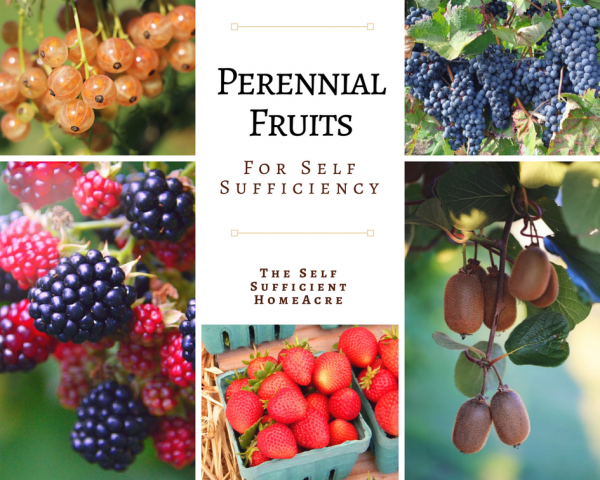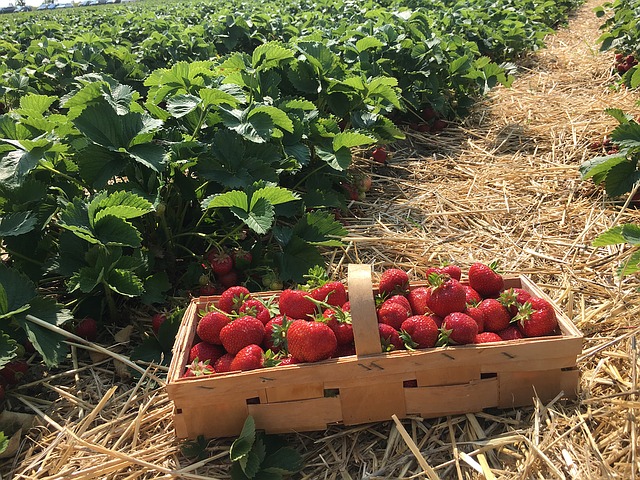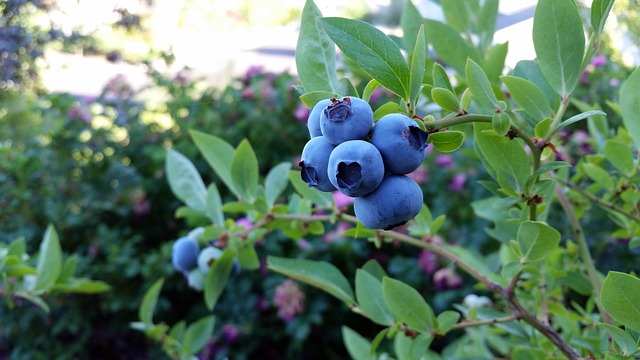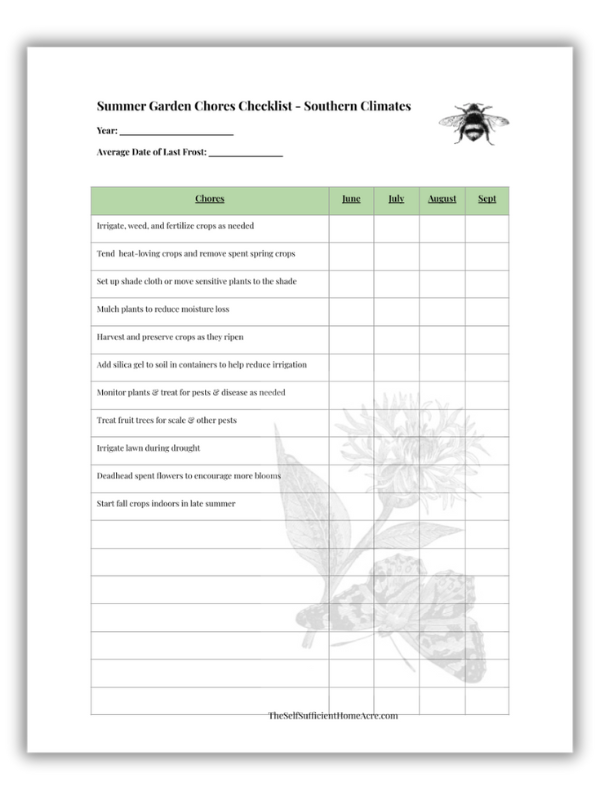
Are you interested in growing your own healthy food, becoming more self-reliant, saving money, and planning for the future? If you answered yes to any of those questions, you’ll be happy to know that perennial fruits will help accomplish all of these goals. Your initial investment of time and money will reward you for years to come. Prepare your perennial beds properly, water and weed your plants, top dress with some compost, and you can harvest fresh food for your table year after year.
In addition to these perennial fruits, you may grow Perennial Vegetables to increase your self-reliance.
This page contains affiliate links. You will not pay any extra when you purchase products through these links, but I will receive a small commission. Thank you for supporting The Self Sufficient HomeAcre!
Small Perennial Fruits for the Home Garden
Small fruits are ideal for gardeners with limited space. They don’t take up as much room as most fruit trees and can often be tucked into suburban and urban spaces that receive full sun. Do some research to find out what zone you live in and what plants do best in your area.
Watch to see how much sun your planting areas receive, and think carefully about how much space you have available. If prime gardening space is limited, you might be able to train grapevines up a vertical trellis, plant strawberries in pots, choose smaller varieties or plant intensively for increased harvests.

Propagate Your Own
You can start out with just a few plants and propagate more to save money. If you have room for a nursery bed, use that space to grow new plants. Grapes grow quite easily by layering or cuttings. Brambles produce new plants by layering also, or by suckering. Strawberries send out runners that can be trained into rows, or the new plants can be transplanted to a new spot. An abundance of new plants may be produced with some time and patience.
Strawberries
Strawberries are one of the easiest fruits for the home garden. They grow best in sandy loam that is slightly acidic. Plant in full sun in an area where no nightshade crops (tomatoes, potatoes, etc.) have been planted in the last 3 years to prevent the spread of Verticillium Wilt. Most strawberry plants will begin to produce in their second year and will last up to five years with regular maintenance and fertilizing.
Choose June Bearing strawberries for a large harvest over 2 or 3 weeks in the spring. Everbearing plants will produce 2 or 3 smaller harvests and day-neutral plants produce throughout the season.
For June bearing plants the best harvests are achieved with light dressings of compost or a balanced fertilizer shortly before flowering and again after the June bearing harvest is over.
Everbearing and day-neutral plants will require more frequent top dressing with compost or a light application of fertilizer. Renovate your June bearing patch by mowing or cutting back the top growth after harvest. Be careful not to cut into the crown.

Grapes
Grapes are woody vines that can live well over 50 years. They like a deep, rich loam that is well-drained and receives full sun. The fruit grows on year-old wood and vines will produce best when properly trained and pruned. Provide plenty of air circulation to prevent fungal infections, and a trellis or fence for the vines to grow on. Tie grapevines to supports to keep fruit from growing on the ground where rot is more prevalent.
Choose varieties suited for your climate and your needs. Table grapes are best for eating out of hand, while wine grapes are often seedy and better suited for juicing and fermenting. Grapes can be grown in insulated pots or they may be espaliered to save space. Planting a marginally hardy variety along a south-facing wall will provide a more hospitable micro-climate.
Kiwi
Kiwis thrive in moist garden soil that is well-drained and neutral or slightly acidic. Hardy varieties can be planted in northern climates, although the fruit will be smaller. Plant one male plant to 3 or 4 female plants for pollination. A light application of fertilizer before spring growth and again after fruiting will increase yields, but be careful not to over-fertilize. Cuttings can be made in midsummer to propagate new plants. Prune male plants any time after flowering and female plants after harvest. Remove 1/3 of current season’s growth to increase yields the following year.
Brambles
Blackberries and raspberries come in many varieties and colors. They grow on thorny canes (although thornless varieties are available) that require staking for best results. Brambles tolerate poor soil in full sun to light shade. A well-drained spot that you can mow around is ideal since brambles tend to send out suckers and long canes that will turn your yard into a thorny jungle. Tops of canes can be trimmed to keep plants in check.
Blackberries bear fruit on second-year growth and will fruit for about a month. Remove fruiting branches when the harvest is complete to keep hedges maintained. Most raspberries also grow on second-year wood, but some varieties produce fruit on new growth and will fruit twice each season.
Blueberries
Blueberries require acidic soil and will not do well in alkaline or neutral beds. Plant them in full sun in a spot with rich, organic soil that is moist but well-drained. Although blueberry plants will begin fruiting in their 3rd or 4th year, sizable harvests will not be achieved for 5 or 6 years.
These are probably the most difficult small fruit to grow in your home garden and may not be suitable for all areas. Use an acidic fertilizer and keep the soil moist, but not soggy. Propagating plants is also trickier and requires patience.
The three main categories of blueberries are Highbush (grow best in northern climates), Rabbiteye (native to southern states), and Southern Highbush (a hybrid of Highbush and Rabbiteye – produces increased yields in milder climates). Highbush are self-fruitful but will produce more fruit if two or more varieties are planted together. Rabbiteye are not self-fruitful, so at least 2 varieties must be planted together for pollination. Southern Highbush also produce best with two or more varieties planted together.
Dwarf Blueberries may be planted in pots or very tight spaces. They give another option to urban and suburban gardeners working toward a higher level of self-sufficiency in small spaces.
Currents and Gooseberries
These members of the Ribes family are restricted in some states where White Pines are important to the economy. Check before planting these, as they are the alternate host for White Pine blister rust.
Currents and gooseberries prefer light shade and cool, moist soil for best growth. Top dress with compost in spring and avoid over-fertilizing. Allow 3 to 5′ between bushes and 8 to 10′ between rows. Prune plants while they are dormant to thin out old wood. The fruit is produced on year-old wood and will continue to produce for several years on each cane.
The main types available are white, red, and black currant and white or pink gooseberry. All produce a tart, flavorful fruit that tends to be rather seedy. The fruits are high in nutritional value and make excellent juices and jellies. Eating fresh from the bush may not appeal to everyone.
This is not a complete list of perennial fruits that can be planted on your homestead, but rather a sampling. There are many more types of small fruits that grow well in mild climates!
Do you have perennial fruits in your garden? What is your favorite? Leave a comment!
As an Amazon Associate, I earn from qualifying purchases.












We’ve tried to grow all of these except for currants.
Our kiwis did not ever fully ripen because our season was not longest. They were about the size of big grapes.
We enjoyed the gooseberries. Ours had a ton of thorns, though!
We’ve done raspberries, blackberries, and blueberries, with the most successful and enjoyable for us being the blueberries. They do take a long time to get regular fruit, but then you get a nice predictable supply.
I’d have to say that perennial fruits are some of our favorite plants!
Thanks for sharing the the Homestead Blog Hop!
We just planted 2 kiwi vines this past fall (one make & one female), can’t wait to see if we get any fruit this year! 🙂 Thanks for sharing on Wildcrafting Wednesday! 🙂
Best wishes with your kiwi vines, Katherine!
I do have blueberries,blackberries, raspberries, strawberries, elderberries and fruit trees. They’re always the first thing I plant no matter where we live!
Smart thinking, Manuela! Every time we move I bring along some grapes, strawberries, raspberries…whatever I can. Last time very few things survived the trip. Moving at the end of June was just too hard on them. 🙁
Happy Gardening!
Thanks for the tips and pointers! I am looking to update my raspberry bed (wish it was surrounded by grass for easy mowing rouge plants) and my strawberries did not make it through a second year of drought. I may try June bearing this time though. We want a lot all at once! I like to freeze them but mostly we are in constant competition with birds to get any. Hehe…
Take care!
Dee
Hi Dee,
Ah yes, those brambles are lots of fun, aren’t they? 🙂 I have mine planted along a fence and I can mow along either side.
I understand about wanting the strawberries all at once. I used to have everbearing, but they didn’t really have many berries after the first flush in June. Now I have all Earliglow and the berries and very yummy. I like to make jam and freeze crushed strawberries with a little sugar…nothing beats it in yogurt! Best wishes with the new strawberry patch!
Great post Lisa! I would love to try the new compact blueberries sometime in the future. We used to grow grapes for years (4 vines) but eventually took them out. I would make grape jelly from them for the family. My grandfather used to have a small vineyard and would sell to Smucker’s in our area. I grew them for the memories I think…well, and for the jelly too! 🙂
Hi Nancy,
Those cute little blueberry bushes call to me too. 🙂 So far I have resisted. I did buy some larger plants and put them in the ground, but I’m not so sure they are doing very well. Our drought last year really did a number on them, in spite of all the water I gave them. 🙁
I loved my concord grapes at our last place. Now I’m waiting for my new ones to produce fruit. I might transplant them this year. They are along our fence line next to the neighbors and they are planting field corn there this year…which means herbicides will be sprayed on our grapes. 🙁 So transplanting will probably be best.
Thanks for sharing your gardening experience with us! The jelly sounds yummy! I used to make jelly from the concord grape juice. 🙂
Thank you so much for this post!
I have two brambles; a red raspberry, and what I think to be a black raspberry. My red raspberry was completely mown over last year (I know have fences surrounding both bushes, haha) so we’ll see if this year will count as a first or second.
Is it possible to transplant the suckers to grow separate raspberry bushes? I was thinking of transplanting one, potting it, and giving it as a gift to someone.
We have an apple tree that does very poorly every year. It wasn’t trained, and it seems beyond hope, unless we chopped down all the branches to the trunk and allowed it to regrow its branches. LOL That wouldn’t go over well..
I have a strawberry plant that I plan to transplant into a larger container. I believe the soil has become too compact. I also want it to give more room for roots.
So far I love my favorite perennial has to be my brambles. I just love them, not sure why. I think they remind me of the countryside! (I live in the suburbs with my family.)
Many Blessings,
Moriah Jordan Miller
Hi Moriah,
Some red raspberries will fruit on first year wood…it depends on the variety you planted. You can transplant the suckers to a new spot. Suckers grow from underground and come up a little bit away from the plant. You want to wait until the sucker has roots on it for best transplanting results.
Your apple tree may need some serious pruning, but cutting all of the branches off won’t be healthy for it. The best thing to do would be to go through and remove all of the suckers (spindly branches with no fruiting spurs) for this year. Most pruning is best done in the late winter, but you can remove the suckers and any diseased or damaged branches, or small branches from the interior of the tree. Try to do this on a cloudy, cool day.
Your strawberry plant should do fine when you transplant it. Give it some nice compost along with the fresh potting soil and make sure the container has drainage holes.
Best wishes and thanks so much for commenting! I love to hear what is up in other gardens. 🙂
Great tips – we’re just getting ready to plant some fruit bushes here.
I would love for you to link up this – and your other gardening posts – at the Empty Your Archive link party. We have a special focus this week on gardening, Alice @ Mums Make Lists x
I’m so excited that our Strawberries are doing so well this year. Last year wasn’t very good.
Thanks for sharing at Tuesdays with a Twist!
Thanks for inviting me, Mary!
We’re planting our 1st 2 blueberry bushes today. I did some reading and found out to water with 2 tablespoons of vinegar to a gallon of water for a fast ph soil fix. You have to be careful not to make it too acidic. We’ll be picking up a soil test kit soon. We’ll also be mulching with pine needles and oak leaves. We have pawpaws here and some wild blackberries. Also a poor, neglected grape vine we’ll work on. Great info. Thanks! 🙂
Hi Little Acres,
Best wishes with the blueberries! I have never tried the vinegar solution. Good to know! I’ve always wanted pawpaws, but our winters get too cold. This is a recurring theme in my garden. 🙂
I’d love to hear about your grape vine renovation 🙂 My grandparents had 2 rows of concord grapes when I was a kid. I don’t know if they’re still there. I loved those grape vines and would eat every grape I could find. I think my Gram would have liked to get more fruit from her orchard and bushes, but I was like the birds and ate my fill before she could harvest!
We always had several rows of raspberry bushes growing in our backyard the whole time I was growing up. I remember playing outside for hours, then when we got hungry, we’d stand there and pick raspberries and eat them right off the bushes. It’s a nice memory!
Hi Mindy,
Nothing beats raspberries fresh off the bush! As a kid I was always enthralled by picking and eating fruit and veggies straight from the plants 🙂
We have red and black currents, blackberries, strawberries, gooseberries, elderberries and aronia. This year I’m planting some rapsberries. My favourites are blackberries although they are really nasty but worth it. 🙂
Hi Regula,
We have red currents here and I’ve had the black currents in the past…they were a little hard to get used to, for me. I can’t believe I forgot elderberries! They are my Dad’s favorite! Thanks for sharing!
Elderberries grow for free. We have so many:-)
Very cool 🙂 They grow wild where I grew up, but I don’t have any here. The one I planted died. 🙁
We have some raspberry plants, blueberry bushes, and a strawberry patch. All of it is new so I don’t know if we should expect any fruit this year or next. Our soil is alkaline, perhaps I need to spread a bit of organic matter over top of the strawberries. I treated the blueberries when I planted them, but I do think it’s time for another treatment. I’ll have to mark that into the calendar. 🙂
Hi Rachel,
I have alkaline soil too and my strawberries do pretty well. Adding a little acid will be fine, but be sure it isn’t too strong. Your blueberries will probably need to have acid fertilizer applied twice each season. I’m hoping to find some pine needles to mulch mine…that will help too.
Best wishes with your perennial fruits!
We love our blueberry and blackberrry bushes and our fig tree. Perennials are such a great way to simplify your garden.
Hi Becky,
I would love to have a fig tree, but it’s just too cold here. Blackberries are marginal too. My blueberry bushes were planted last year and we’ll see how they do. Our soil is pretty alkaline so I need to fertilize with acid.
Thanks for stopping by!